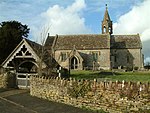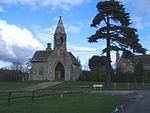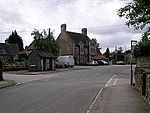Leigh Delamere
EngvarB from August 2019Former civil parishes in WiltshireVillages in Wiltshire

Leigh Delamere is a small village in the civil parish of Grittleton in the English county of Wiltshire, about 4 miles (6 km) northwest of the town of Chippenham. The M4 motorway passes some 250 metres to the south, and the motorway's Leigh Delamere services lie to the east of the village. The civil parish of Leigh Delamere (which included the hamlet of Sevington, about one mile southwest of the village) was absorbed by Grittleton parish on 1 April 1934. In 1931 the parish had a population of 96.
Excerpt from the Wikipedia article Leigh Delamere (License: CC BY-SA 3.0, Authors, Images).Leigh Delamere
Geographical coordinates (GPS) Address Nearby Places Show on map
Geographical coordinates (GPS)
| Latitude | Longitude |
|---|---|
| N 51.512 ° | E -2.168 ° |
Address
SN14 6JZ , Grittleton
England, United Kingdom
Open on Google Maps








